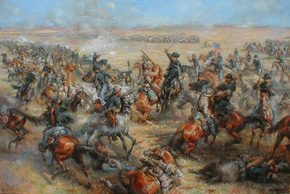 |
Civil War Battles |
|
State War Records |
| AL - AK - AZ - AR - CA - CO - CT - DE - FL - GA - HI - ID - IL - IN - IA - KS - KY - LA - MA - MD - ME - MI - MN - MS - MO - MT - NE - NV - NH - NJ - NM - NY - NC - ND - OH - OK - OR - PA - RI - SC - SD - TN - TX - UT - VT - VA - WA - WV - WI - WY |
The Battle of Mine Creek
October 25, 1864 in Linn County, Kansas
 |
|||||||||||||||||
|
In October, 1864, a Confederate Army under Gen. Sterling Price was defeated near Kansas City. He retreated south, crossed into Kansas, and camped at Trading Post. Early on the morning of October 25 Union troops under Generals Pleasonton, Blunt, and Curtis forced him from this position, and a few hours later the Battle of Mine Creek was fought over these fields.
About six miles south of Trading Post, where the Marais de Cygnes engagement had occurred, the brigades of Col. Frederick W. Benteen and Col. John F. Phillips, of Maj. Gen. Alfred Pleasonton's Provisional Cavalry Division, overtook the Confederates as they were crossing Mine Creek. These Confederates, stalled by their wagons crossing the ford, had formed a line on the north side of Mine Creek.
The Federals, although outnumbered, commenced the attack as additional troops from Pleasonton's command arrived during the fight. Benteen spotted a key defect in the Confederate line: they had deployed on the back side of a ridge, so the Union charge would come as a surprise. Benteen mounted and hurled his brigade into action, and they did break the Confederate line. Reinforcements from Pleasonton arrived during the fighting, and kept the pressure on.
They soon surrounded the Rebel rearguard, capturing about 600 men, 10 guns, and 2 generals, Marmaduke and Brig. Gen. William L. Cabell. Marmaduke had been thrown from his horse in a melee, and was apprehended as he staggered westward. The Union cavalry had trouble moving through the confusion of the Confederate wagon train, bogged down in the creek fords, and then through the woods south of the creek. Still, over time their numbers were enough to drive the Confederates further south, and there was more fighting at the Marmiton River. Having lost this many men, Price's army was doomed. Retreat to friendly territory was the only recourse.
Although Union forces missed a chance to destroy Price's army, the defeat was decisive enough to end the threat of a Confederate invasion of Kansas. About 25,000 men were engaged, more than in any other Kansas battle.
